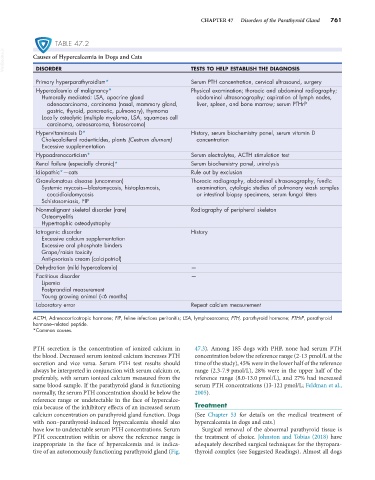Page 789 - Small Animal Internal Medicine, 6th Edition
P. 789
CHAPTER 47 Disorders of the Parathyroid Gland 761
TABLE 47.2
VetBooks.ir Causes of Hypercalcemia in Dogs and Cats TESTS TO HELP ESTABLISH THE DIAGNOSIS
DISORDER
Primary hyperparathyroidism* Serum PTH concentration, cervical ultrasound, surgery
Hypercalcemia of malignancy* Physical examination; thoracic and abdominal radiography;
Humorally mediated: LSA, apocrine gland abdominal ultrasonography; aspiration of lymph nodes,
adenocarcinoma, carcinoma (nasal, mammary gland, liver, spleen, and bone marrow; serum PTHrP
gastric, thyroid, pancreatic, pulmonary), thymoma
Locally osteolytic (multiple myeloma, LSA, squamous cell
carcinoma, osteosarcoma, fibrosarcoma)
Hypervitaminosis D* History, serum biochemistry panel, serum vitamin D
Cholecalciferol rodenticides, plants (Cestrum diurnum) concentration
Excessive supplementation
Hypoadrenocorticism* Serum electrolytes, ACTH stimulation test
Renal failure (especially chronic)* Serum biochemistry panel, urinalysis
Idiopathic*—cats Rule out by exclusion
Granulomatous disease (uncommon) Thoracic radiography, abdominal ultrasonography, fundic
Systemic mycosis—blastomycosis, histoplasmosis, examination, cytologic studies of pulmonary wash samples
coccidioidomycosis or intestinal biopsy specimens, serum fungal titers
Schistosomiasis, FIP
Nonmalignant skeletal disorder (rare) Radiography of peripheral skeleton
Osteomyelitis
Hypertrophic osteodystrophy
Iatrogenic disorder History
Excessive calcium supplementation
Excessive oral phosphate binders
Grape/raisin toxicity
Anti-psoriasis cream (calcipotriol)
Dehydration (mild hypercalcemia) —
Factitious disorder —
Lipemia
Postprandial measurement
Young growing animal (<6 months)
Laboratory error Repeat calcium measurement
ACTH, Adrenocorticotropic hormone; FIP, feline infectious peritonitis; LSA, lymphosarcoma; PTH, parathyroid hormone; PTHrP, parathyroid
hormone–related peptide.
*Common causes.
PTH secretion is the concentration of ionized calcium in 47.3). Among 185 dogs with PHP, none had serum PTH
the blood. Decreased serum ionized calcium increases PTH concentration below the reference range (2-13 pmol/L at the
secretion and vice versa. Serum PTH test results should time of the study), 45% were in the lower half of the reference
always be interpreted in conjunction with serum calcium or, range (2.3-7.9 pmol/L), 28% were in the upper half of the
preferably, with serum ionized calcium measured from the reference range (8.0-13.0 pmol/L), and 27% had increased
same blood sample. If the parathyroid gland is functioning serum PTH concentrations (13-121 pmol/L; Feldman et al.,
normally, the serum PTH concentration should be below the 2005).
reference range or undetectable in the face of hypercalce-
mia because of the inhibitory effects of an increased serum Treatment
calcium concentration on parathyroid gland function. Dogs (See Chapter 53 for details on the medical treatment of
with non–parathyroid-induced hypercalcemia should also hypercalcemia in dogs and cats.)
have low to undetectable serum PTH concentrations. Serum Surgical removal of the abnormal parathyroid tissue is
PTH concentration within or above the reference range is the treatment of choice. Johnston and Tobias (2018) have
inappropriate in the face of hypercalcemia and is indica- adequately described surgical techniques for the thyropara-
tive of an autonomously functioning parathyroid gland (Fig. thyroid complex (see Suggested Readings). Almost all dogs

